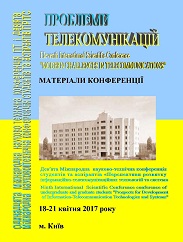PERSPECTIVES OF ALGORITHMS TRANSFORMATION OF NOISE-IMMUNE SIGNALING OF DVB-T2 STANDARD INTO A DUPLEX COMMUNICATION SYSTEM
Анотація
ПЕРСПЕКТИВЫ ТРАНСФОРМАЦИИ АЛГОРИТМОВ
ПОМЕХОУСТОЙЧИВОЙ ПЕРЕДАЧИ СИГНАЛОВ СТАНДАРТА
DVB-T2 В ПРОТОКОЛЫ ДУПЛЕКСНОЙ СВЯЗИ
В данной работе рассматриваются новшества, внедренные в стандарт телевизионного вещания DVB-T2, с точки зрения переноса его особенностей из системы c односторонней передачей в дуплексные многопользовательские системы. Детально рассмотрены механизмы обеспечения устойчивости сигнала в пределах физического канала. Значительное внимание в статье уделено особенностям стандарта, отвечающим за мультисервисность системы.
Посилання
Frame structure channel coding and modulation for a second generation digital terrestrial television broadcasting system (DVB-T2). – Draft ETSI EN 302 755 V1.4.1, February 2015.
Balyar V.B. Comparative characteristics of digital terrestrial television broadcasting standards of DVB-T/T2/V.B. Balyar, O.V. Gofaizen // Digital technology. - 2012. - Vol. 11. - P. 31-46.
##submission.downloads##
Як цитувати
Номер
Розділ
Ліцензія
Авторське право (c) 2017 Марія Вячеславівна Шевченко, Леонід Олександрович Уривський

Ця робота ліцензується відповідно до Creative Commons Attribution 4.0 International License.
Authors who submit to this conference agree to the following terms:a) Authors retain copyright over their work, while allowing the conference to place this unpublished work under a Creative Commons Attribution License, which allows others to freely access, use, and share the work, with an acknowledgement of the work's authorship and its initial presentation at this conference.
b) Authors are able to waive the terms of the CC license and enter into separate, additional contractual arrangements for the non-exclusive distribution and subsequent publication of this work (e.g., publish a revised version in a journal, post it to an institutional repository or publish it in a book), with an acknowledgement of its initial presentation at this conference.
c) In addition, authors are encouraged to post and share their work online (e.g., in institutional repositories or on their website) at any point before and after the conference.

